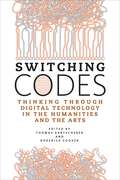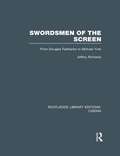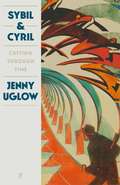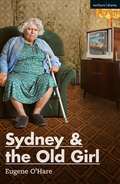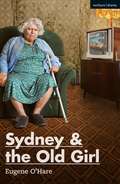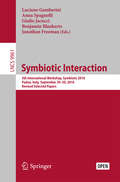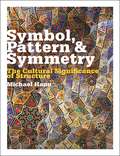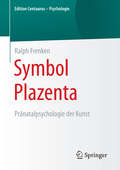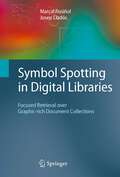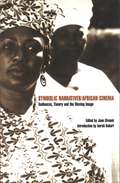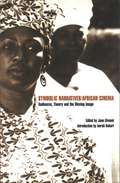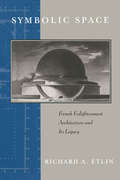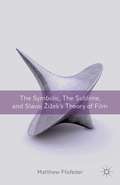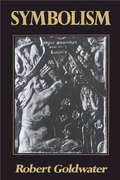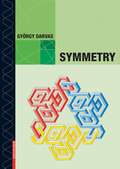- Table View
- List View
Switching Codes: Thinking Through Digital Technology in the Humanities and the Arts
by Thomas Bartscherer Roderick CooverHalf a century into the digital era, the profound impact of information technology on intellectual and cultural life is universally acknowledged but still poorly understood. The sheer complexity of the technology coupled with the rapid pace of change makes it increasingly difficult to establish common ground and to promote thoughtful discussion. Responding to this challenge, Switching Codes brings together leading American and European scholars, scientists, and artists—including Charles Bernstein, Ian Foster, Bruno Latour, Alan Liu, and Richard Powers—to consider how the precipitous growth of digital information and its associated technologies are transforming the ways we think and act. Employing a wide range of forms, including essay, dialogue, short fiction, and game design, this book aims to model and foster discussion between IT specialists, who typically have scant training in the humanities or traditional arts, and scholars and artists, who often understand little about the technologies that are so radically transforming their fields. Switching Codes will be an indispensable volume for anyone seeking to understand the impact of digital technology on contemporary culture, including scientists, educators, policymakers, and artists, alike.
Switching Codes: Thinking Through Digital Technology in the Humanities and the Arts
by Thomas Bartscherer and Roderick CooverHalf a century into the digital era, the profound impact of information technology on intellectual and cultural life is universally acknowledged but still poorly understood. The sheer complexity of the technology coupled with the rapid pace of change makes it increasingly difficult to establish common ground and to promote thoughtful discussion. Responding to this challenge, Switching Codes brings together leading American and European scholars, scientists, and artists—including Charles Bernstein, Ian Foster, Bruno Latour, Alan Liu, and Richard Powers—to consider how the precipitous growth of digital information and its associated technologies are transforming the ways we think and act. Employing a wide range of forms, including essay, dialogue, short fiction, and game design, this book aims to model and foster discussion between IT specialists, who typically have scant training in the humanities or traditional arts, and scholars and artists, who often understand little about the technologies that are so radically transforming their fields. Switching Codes will be an indispensable volume for anyone seeking to understand the impact of digital technology on contemporary culture, including scientists, educators, policymakers, and artists, alike.
Switching Codes: Thinking Through Digital Technology in the Humanities and the Arts
by Thomas Bartscherer and Roderick CooverHalf a century into the digital era, the profound impact of information technology on intellectual and cultural life is universally acknowledged but still poorly understood. The sheer complexity of the technology coupled with the rapid pace of change makes it increasingly difficult to establish common ground and to promote thoughtful discussion. Responding to this challenge, Switching Codes brings together leading American and European scholars, scientists, and artists—including Charles Bernstein, Ian Foster, Bruno Latour, Alan Liu, and Richard Powers—to consider how the precipitous growth of digital information and its associated technologies are transforming the ways we think and act. Employing a wide range of forms, including essay, dialogue, short fiction, and game design, this book aims to model and foster discussion between IT specialists, who typically have scant training in the humanities or traditional arts, and scholars and artists, who often understand little about the technologies that are so radically transforming their fields. Switching Codes will be an indispensable volume for anyone seeking to understand the impact of digital technology on contemporary culture, including scientists, educators, policymakers, and artists, alike.
Switching Codes: Thinking Through Digital Technology in the Humanities and the Arts
by Thomas Bartscherer and Roderick CooverHalf a century into the digital era, the profound impact of information technology on intellectual and cultural life is universally acknowledged but still poorly understood. The sheer complexity of the technology coupled with the rapid pace of change makes it increasingly difficult to establish common ground and to promote thoughtful discussion. Responding to this challenge, Switching Codes brings together leading American and European scholars, scientists, and artists—including Charles Bernstein, Ian Foster, Bruno Latour, Alan Liu, and Richard Powers—to consider how the precipitous growth of digital information and its associated technologies are transforming the ways we think and act. Employing a wide range of forms, including essay, dialogue, short fiction, and game design, this book aims to model and foster discussion between IT specialists, who typically have scant training in the humanities or traditional arts, and scholars and artists, who often understand little about the technologies that are so radically transforming their fields. Switching Codes will be an indispensable volume for anyone seeking to understand the impact of digital technology on contemporary culture, including scientists, educators, policymakers, and artists, alike.
Swordsmen of the Screen: From Douglas Fairbanks to Michael York (Routledge Library Editions: Cinema)
by Jeffrey RichardsThis fascinating study of the genre of swashbuckling films received wide critical acclaim when it was first published in 1977. Jeffrey Richards assesses the contributions to the genre of directors, designers and fencing masters, as well as of the stars themselves, and devotes several chapters to the principal subjects if the swashbucklers – pirates, highwaymen, cavaliers and knights. The result is to recall, however fleetingly, the golden days of the silver screen. Reviews of the original edition: ‘An intelligent, scholarly, well-written account of adventure films, this work is sensitive both to cinema history and to the literary origins of the "swashbuckler"….Essential for any library with books on film, it may very well be the definitive book on its subject.’ – Library Journal
Swordsmen of the Screen: From Douglas Fairbanks to Michael York (Routledge Library Editions: Cinema)
by Jeffrey RichardsThis fascinating study of the genre of swashbuckling films received wide critical acclaim when it was first published in 1977. Jeffrey Richards assesses the contributions to the genre of directors, designers and fencing masters, as well as of the stars themselves, and devotes several chapters to the principal subjects if the swashbucklers – pirates, highwaymen, cavaliers and knights. The result is to recall, however fleetingly, the golden days of the silver screen. Reviews of the original edition: ‘An intelligent, scholarly, well-written account of adventure films, this work is sensitive both to cinema history and to the literary origins of the "swashbuckler"….Essential for any library with books on film, it may very well be the definitive book on its subject.’ – Library Journal
Sybil & Cyril: Cutting through Time
by Jenny Uglow'Whatever Uglow writes about she makes absolutely fascinating.' DIANA ATHILLThe story of Sybil Andews and Cyril Power, two artists who changed each other in an age of experiment and turmoil.'In all her books, she makes us feel the life behind the facts.' GUARDIAN'Wonderfully sharp and sympathetic . . . Uglow is a perfect biographer.' CRAIG BROWN, MAIL ON SUNDAYIn 1922, Cyril Power, a fifty-year-old architect, left his family to work with the twenty-four-year-old Sybil Andrews. They would be together for twenty years. Both became famous for their dynamic, modernist linocuts, streamlined, full of movement and brilliant colour, summing up the hectic interwar years. Yet at the same time they looked back, to medieval myths and early music, to country ways disappearing from sight.Cyril & Sybil traces their struggles and triumphs, conflicts and dreams, following them from Suffolk to London, from the New Forest to Vancouver Island. This is a world of Futurists, Surrealists and pioneering abstraction, but also of the buzz of the new, of machines and speed, shops and sport and dance, shining against the threat of depression and looming shadows of war.
Sydney Opera House, Australia (Large Print)
by Rnib BookshareThis is an image of the Sydney Opera House, seen from the side, showing its famous roof. There is a locator dot shown, which will be at the top left of the page when the image is the right way up. It is surrounded by a dashed image border. Across the bottom of the image water spans the page. Just up from this is the pedestrian platform, terrace and side walls which span the length of the building. Up from these is a series of distinctive arched shells that form the roof of the opera house.
Sydney Opera House, Australia (UEB Contracted)
by Rnib BookshareThis is an image of the Sydney Opera House, seen from the side, showing its famous roof. There is a locator dot shown, which will be at the top left of the page when the image is the right way up. It is surrounded by a dashed image border. Across the bottom of the image water spans the page. Just up from this is the pedestrian platform, terrace and side walls which span the length of the building. Up from these is a series of distinctive arched shells that form the roof of the opera house.
Sydney Opera House, Australia (UEB uncontracted)
by Rnib BookshareThis is an image of the Sydney Opera House, seen from the side, showing its famous roof. There is a locator dot shown, which will be at the top left of the page when the image is the right way up. It is surrounded by a dashed image border. Across the bottom of the image water spans the page. Just up from this is the pedestrian platform, terrace and side walls which span the length of the building. Up from these is a series of distinctive arched shells that form the roof of the opera house.
Sydney & the Old Girl (Modern Plays)
by Eugene O'HareLondon is becoming an alien landscape to Sydney Stock; a man who has lived for over fifty years cooped with his mother Nell in her grubby East End home. Theirs is a relationship of mutually assured destruction where the ghosts of the past continue to stalk and accuse. As the twisted game around family inheritance reaches breaking point, Irish care worker Marion Fee finds herself an unwitting pawn being played from both sides. At the centre of Eugene O'Hare's second full-length black comedy is a family's obsession with versions of the past and a paranoia about a future in a city which no longer feels like home.This edition was published to coincide with the world premiere at Park Theatre, London in November 2019.
Sydney & the Old Girl (Modern Plays)
by Eugene O'HareLondon is becoming an alien landscape to Sydney Stock; a man who has lived for over fifty years cooped with his mother Nell in her grubby East End home. Theirs is a relationship of mutually assured destruction where the ghosts of the past continue to stalk and accuse. As the twisted game around family inheritance reaches breaking point, Irish care worker Marion Fee finds herself an unwitting pawn being played from both sides. At the centre of Eugene O'Hare's second full-length black comedy is a family's obsession with versions of the past and a paranoia about a future in a city which no longer feels like home.This edition was published to coincide with the world premiere at Park Theatre, London in November 2019.
Symbiotic Interaction: 5th International Workshop, Symbiotic 2016, Padua, Italy, September 29–30, 2016, Revised Selected Papers (Lecture Notes in Computer Science #9961)
by Luciano Gamberini Anna Spagnolli Giulio Jacucci Benjamin Blankertz Jonathan FreemanThis book is published open access under a CC BY license.This book constitutes the proceedings of the 5th International Workshop on Symbiotic Interaction, Symbiotic 2016, held in Padua, Italy, in October 2016.The 12 full papers and 3 short papers presented in this volume were carefully reviewed and selected from 23 submissions. The idea of symbiotic systems put forward in this workshop capitalizes on the computers’ ability to implicitly detect the users goals, preferences or/and psycho-physiological states and thereby enhancing human-computer interaction (HCI). The papers present an overview of the symbiotic relationships between humans and computers with emphasis on user-driven research on symbiotic systems, adaptive systems, implicit input data, physiological computing and BCI, but also on understanding the nature of the interdependence and agency between computers and humans more broadly.
Symbol of the Judicial Committee of the Privy Council (The Supreme Court of the United Kingdom) (UEB contracted)
by RnibIn Court Room Three of the UKSC (The Supreme Court of the United Kingdom) on the carpet in front of the Justices' bench is the symbol for the JCPC which is also the emblem for the Order of the Garter. King Edward III founded the Order in 1348 as a society, fellowship and college of knights. There are various stories as to the origin of the order, one of the most popular being that when the king was dancing with a lady of the court, her garter belt slipped off to the amusement of the male courtiers. The King turned on them angrily saying "Honi soit qui mal y pense" or œshamed be he who thinks evil. In a modern court setting perhaps, not enter with evil thoughts would be a more appropriate translation. The symbol consists of a garter in the form of a circular stylised belt with a buckle, holes to adjust the belt and an ornate strap-end.Around the belt in capital letters are the words 'HONI SOIT QUI MAL Y PENSE'. The inside of the circle has been divided into four equal quadrants. Top left and bottom right quadrants show three lions passant (in side profile walking to the left with the right front paw raised), for England, deriving from a royal seal used by Richard (the Lionheart). Top right shows a lion rampant (side profile standing erect facing to the left with front paws raised) in a border, first used by William of Scotland in the 12 century as a symbol of his country. Bottom left shows a harp complete with strings, usually used to represent the Kingdom of Ireland but here it represents Northern Ireland, the harp in its plain Gaelic form, rather than having a winged female attached as in earlier versions.Surmounting the circle is a royal crown. On the carpet, the symbol (160 by 102 centimetres or 5 feet 3 inches by 3 feet 4 inches) is on a dark green background. The detail is shown as black on different coloured backgrounds - light green for the garter, royal blue and light blue alternating in the quadrants, and red under the crown. The buckle, strap-ends and base of the crown are sandy-brown. The tactile image is nearly six times smaller than the symbol on the carpet.Thick lines show the structure of the symbol and lettering.Solid texture shows the crown, lions, harp, buckle, strap-ends and adjusting holes.
Symbol, Pattern and Symmetry: The Cultural Significance of Structure
by Michael HannSymbol, Pattern and Symmetry: The Cultural Significance of Structure investigates how pattern and symbol has functioned in visual arts, exploring how connections and comparisons in geometrical pattern can be made across different cultures and how the significance of these designs has influenced craft throughout history.The book features illustrative examples of symbol and pattern from a wide range of historical and cultural contexts, from Byzantine, Persian and Assyrian design, to case studies of Japanese and Chinese patterns. Looking at each culture's specific craft style, Hann shows how the visual arts are underpinned with a strict geometric structure, and argues that understanding these underlying structures enables us to classify and compare data from across cultures and historical periods.Richly illustrated with both colour and black and white images, and with clear, original commentary, the book enables students, practitioners, teachers and researchers to explore the historical and cultural significance of symbol and pattern in craft and design, ultimately displaying how a geometrical dialogue in design can be established through history and culture.
Symbol, Pattern and Symmetry: The Cultural Significance of Structure
by Michael HannSymbol, Pattern and Symmetry: The Cultural Significance of Structure investigates how pattern and symbol has functioned in visual arts, exploring how connections and comparisons in geometrical pattern can be made across different cultures and how the significance of these designs has influenced craft throughout history.The book features illustrative examples of symbol and pattern from a wide range of historical and cultural contexts, from Byzantine, Persian and Assyrian design, to case studies of Japanese and Chinese patterns. Looking at each culture's specific craft style, Hann shows how the visual arts are underpinned with a strict geometric structure, and argues that understanding these underlying structures enables us to classify and compare data from across cultures and historical periods.Richly illustrated with both colour and black and white images, and with clear, original commentary, the book enables students, practitioners, teachers and researchers to explore the historical and cultural significance of symbol and pattern in craft and design, ultimately displaying how a geometrical dialogue in design can be established through history and culture.
Symbol Plazenta: Pränatalpsychologie der Kunst (Edition Centaurus – Psychologie)
by Ralph FrenkenDas Buch stellt eine Auseinandersetzung mit den frühesten Objekterfahrungen des menschlichen Fötus dar. Die Pränatalpsychologie zeigt die Auswirkungen früher Erlebnisse auf Psychotherapien, auf Kunstwerke und die Religion. Ausgangspunkt ist: Der Fötus erlebt als erstes Objekt seine Plazenta. Er ist mit ihr über die Nabelschnur verbunden, er berührt sie und bildet zu ihr die erste Beziehung seines Lebens aus. Nach der Geburt zeigen sich Widerspiegelungen dieser ersten Beziehung im Umgang mit Übergangsobjekten, in Kinderzeichnungen und in der Phantasiewelt des Kindes. Vom Baum des Lebens im Paradies bis zum Roten Drachen der Apokalypse zeigen sich in der Kunst und in der Religion die Auswirkungen früher Erfahrungen – und werden durch das vorliegende Werk verstehbar.
Symbol Spotting in Digital Libraries: Focused Retrieval over Graphic-rich Document Collections
by Marçal Rusiñol Josep LladósPattern recognition basically deals with the recognition of patterns, shapes, objects, things in images. Document image analysis was one of the very ?rst applications of pattern recognition and even of computing. But until the 1980s, research in this ?eld was mainly dealing with text-based documents, including OCR (Optical Character Recognition) and page layout analysis. Only a few people were looking at more speci?c documents such as music sheet, bank cheques or forms. The community of graphics recognition became visible in the late 1980s. Their speci?c interest was to recognize high-level objects represented by line drawings and graphics. The speci?c pattern recognition problems they had to deal with was raster-to-graphics conversion (i.e., recognizing graphical primitives in a cluttered pixel image), text-graphics separation, and symbol recognition. The speci?c problem of symbol recognition in graphical documents has received a lot of attention. The symbols to be recognized can be musical notation, electrical symbols, architectural objects, pictograms in maps, etc. At ?rst glance, the symbol recognition problems seems to be very similar to that of character recognition; - ter all, characters are basically a subset of symbols. Therefore, the large know-how in OCR has been extensively used in graphical symbol recognition: starting with segmenting the document to extract the symbols, extracting features from the s- bols, and then recognizing them through classi?cation or matching, with respect to a training/learning set.
Symbolic Narratives/African Cinema: Audiences, Theory and the Moving Image
by June GivanniIn the conference Africa and the History of Cinematic Ideas held in London in 1995, film-makers, cultural theorists and critics gathered to debate a range of issues. Views were exchanged on such topics as imperialism, and the problems of distribution.
Symbolic Narratives/African Cinema: Audiences, Theory and the Moving Image
In the conference Africa and the History of Cinematic Ideas held in London in 1995, film-makers, cultural theorists and critics gathered to debate a range of issues. Views were exchanged on such topics as imperialism, and the problems of distribution.
Symbolic Space: French Enlightenment Architecture and Its Legacy
by Richard A. EtlinRichard A. Etlin explores the social and cultural hierarchies established in eighteenth-century France to illustrate how the conceptual basis of the modern house and the physical layout of the modern city emerged from debates among theoretically innovative French architects of the eighteenth-century. Examining a broad range of topics from architecture and urbanism to gardening and funerary monuments, he shows how the work of these architects was informed by considerations of symbolic space. For Etlin, the eighteenth-century city was a place in which actual physical space was subjected to a complex mental layering of conceptual spaces. He focuses on the design theory of Boullée and Durand and charts their legacy through the architecture of Paul Philippe Cret, Frank Lloyd Wright, and Louis Kahn. He defines the distinctive features of neoclassicism and outlines the new grammar for classical architecture articulated by theorists and architects such as Laugier, Leroy, and Ledoux. After discussing the eighteenth-century hôtel, revolutionary space, and the transformation of the image of the cemetery, Etlin examines the space of absence as embodied in commemorative architecture from Boullée and Gilly to Cret, Wright, and Terragni. His book provides an accessible introduction to a century of architecture that transformed the classical forms of the Renaissance and Baroque periods into building types still familiar today.
The Symbolic, the Sublime, and Slavoj Zizek's Theory of Film
by M. FlisfederReturning to questions about ideology and subjectivity, Flisfeder argues that Slavoj Žižek's theory of film aims to re-politicize film studies and film theory, bringing cinema into the fold of twenty-first century politics.
Symbolism
by Robert GoldwaterThis encyclopedic guide explores the rich and varied meanings of more than 2,000 symbols?from amethyst to Zodiac.
Symbolism
by Robert GoldwaterThis encyclopedic guide explores the rich and varied meanings of more than 2,000 symbols?from amethyst to Zodiac.
Symmetry: Cultural-historical and Ontological Aspects of Science-Arts Relations; the Natural and Man-made World in an Interdisciplinary Approach
by György DarvasThe first comprehensive book on the topic in half a century explores recent symmetry – and symmetry breaking – related discoveries, and discusses the questions and answers they raise in diverse disciplines: particle and high-energy physics, structural chemistry and the biochemistry of proteins, in genetic code study, in brain research, and also in architectural structures, and business decision making, to mention only a few examples.
